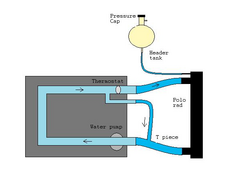NS Dev
|
| posted on 17/8/10 at 02:05 PM |

|
|
Rover v8 cooling system!
Next rover V8 issue of the day!
How should the cooling system be plumbed on an efi v8 (with the std rover inlet manifold)
At the moment, and starting with the obvious, we have the rad top hose going straight to the thermostat housing on the inlet manifold, and the bottom
hose going to the water pump.
Next looking at the front of the inlet manifold, the water connection at the bottom, just in the vee of the engine, is connected to the heater valve
and tee'd into the header tank. The heater valve is a 3 way type which diverts water either to the matrix or to the bottom hose, and the heater
return is also to the bottom hose. The 5/16" bleed connection on the manifold is tee'd into the header tank bleed connection and to the
radiator bleed also.
The "top left" water connection on the inlet manifold is just blanked off (this is the main thing we're not sure about, though it
seems to only be part of the same waterway that we are feeding the heater and a return to the bottom hose from)
Anybody got any opinions?
cheers
Nat
Retro RWD is the way forward...........automotive fabrication, car restoration, sheetmetal work, engine conversion
retro car restoration and tuning
|
|
|
|
|
cd.thomson
|
| posted on 17/8/10 at 02:22 PM |

|
|
what are you putting it in Nat?
Sorry for hijack..
Craig
|
|
|
AdamR
|
| posted on 17/8/10 at 02:26 PM |

|
|
I'm not running a heater, which simplifies things a bit. However, I think your proposed heater plumbing will work fine.
This is my set-up (though I've since moved the header connection into the top hose):
 
Proposed cooling system pumbin
|
|
|
NS Dev
|
| posted on 17/8/10 at 02:39 PM |

|
|
Its the one in the Bedford CF van on our website...
Retro RWD is the way forward...........automotive fabrication, car restoration, sheetmetal work, engine conversion
retro car restoration and tuning
|
|
|
NS Dev
|
| posted on 17/8/10 at 02:42 PM |

|
|
quote:
Originally posted by AdamR
I'm not running a heater, which simplifies things a bit. However, I think your proposed heater plumbing will work fine.
This is my set-up (though I've since moved the header connection into the top hose):
 
Proposed cooling system pumbin
yea that's not dissimilar.
There are two 3/4" connections on the efi inlet manifold, one we've used and one we've blanked.
Problem is its chucking water out of the pressure cap when revved, and yep we've changed the cap, and its fine at idle for as long as you like,
but as soon as its revved it chucks water out!
Retro RWD is the way forward...........automotive fabrication, car restoration, sheetmetal work, engine conversion
retro car restoration and tuning
|
|
|
interestedparty
|
| posted on 17/8/10 at 04:30 PM |

|
|
Sounds like the water sytem is being pressurised. Are your head gaskets OK? How hot is the water that is being forced out?
As some day it may happen that a victim must be found,
I've got a little list-- I've got a little list
Of society offenders who might well be underground,
And who never would be missed-- who never would be missed!
|
|
|
andrew.carwithen
|
| posted on 17/8/10 at 04:32 PM |

|
|
Nat,
have a look at this from the 'how to build a Pilgrim Sumo' website.
May be of help.
http://how-to-build-a-pilgrim-sumo.wikidot.com/engine-plumbing
(halfway-down Rover V8 plumbing diagram plus interesting info about need for a restrictor)
[Edited on 17/8/10 by andrew.carwithen]
|
|
|
craig1410
|
| posted on 17/8/10 at 08:06 PM |

|
|
Nat,
Your problem is probably caused by the fact that the 3/4 pipe you have connected to the header tank will be pushing water into the header tank instead
of pulling it out. I'm assuming your header tank is of the type with a small hose going in at the top and a large hose coming out the bottom.
Think about it - the thermostat is closed and therefore all of the water being pumped by the engine's water pump is being forced into the
header tank. Even if you have the little hose at the top of the header tank, it will only be 8mm or so and will be (should be) connected to the
highest point of the engine which will also be under full water pump pressure.
What you need to do is connect the header tank large pipe to the radiator bottom hose via a coupling of some sort so that water is being pulled from
the header tank. The small hose on the header tank will allow air to bleed from the top of the engine and will then allow a small amount of water to
circulate into the tank via the small hose and then back out the bottom. It will eventually settle to a level equal to the mean water level within the
engine once the engine is turned off.
I would also recommend not combining the bleed hose from the radiator and inlet manifold. If it is a Polo radiator then the bleed connection is right
next to the top hose inlet anyway so it will self bleed. I think the Polo rad bleed hose is only useful if your radiator is higher than the engine
(which it should be really but this is not really possible inside a Seven shaped nosecone. I had problems with weird water flows when I combined my
bleed hoses so I now only have the highest point of the inlet manifold feeding the header tank top hose.
Let me know if this makes any sense. (or not...)
Cheers,
Craig.
|
|
|













